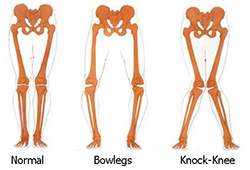 When the Knees do not touch but the feet do it is a case of bowed legs (genu varum).When the knees do touch but the ankles do not it is a case of knock knees (genu valgum). Both of these are common in toddlers and teenagers.
When the Knees do not touch but the feet do it is a case of bowed legs (genu varum).When the knees do touch but the ankles do not it is a case of knock knees (genu valgum). Both of these are common in toddlers and teenagers.
Description
Most children with bowed legs grow out of this before they are three years old. If a toddler does not grow out of the bowed legs, an x-ray may be needed to make sure the child does not have Blount’s disease. Blount’s disease can also occur in overweight teenagers. In children who do not get enough calcium, phosphorous, or vitamin D, bowed legs can occur because of poor nutrition. This condition is called Rickets. Rickets can also occur if a child has a genetic disease that leads to low vitamin D levels.
Knock knees are also normal in toddlers but can take until elementary school to correct on their own. Knock knees that appear later in childhood can be a sign of a bone disease such as osteomalacia or rickets.
Treatment
Most toddlers with bowed legs or knock knees grow out of it without needing any special braces or shoes. Toddlers with bowed legs usually correct by age 3 or 4. Toddlers with knock knees can take until early elementary school to correct on their own, around age 6 or 7.
Blount’s disease:
Toddlers with Blount’s disease may need to be treated with braces. If the brace does not correct the bowing, surgery is usually recommended by the age of 4. Teenagers with Blount’s disease need surgery to correct the bowing. Depending on the age of the child and the amount of bowing, different surgeries may be recommended. One type involves cutting the bone and re-aligning it. Another option is to temporarily stop growth on one side of the growth plate to give the other abnormal side a chance to “catch up” and make the leg straight. A less common surgery involves taking out part of the abnormal growth plate.
Rickets:
If the Rickets is properly treated with medication, the bowing may correct on its own. Surgery is needed if the bowing does not improve after medication.
Knock Knees/Bowed Legs:
Most toddlers and young children will not require any bracing, physical therapy, or special shoes. Older children and growing teenagers may have persistent knock knees or bowed legs. Evaluation by a pediatric orthopaedic surgeon is appropriate if there are limitations in activities activity, pain, or substantial deformity.
